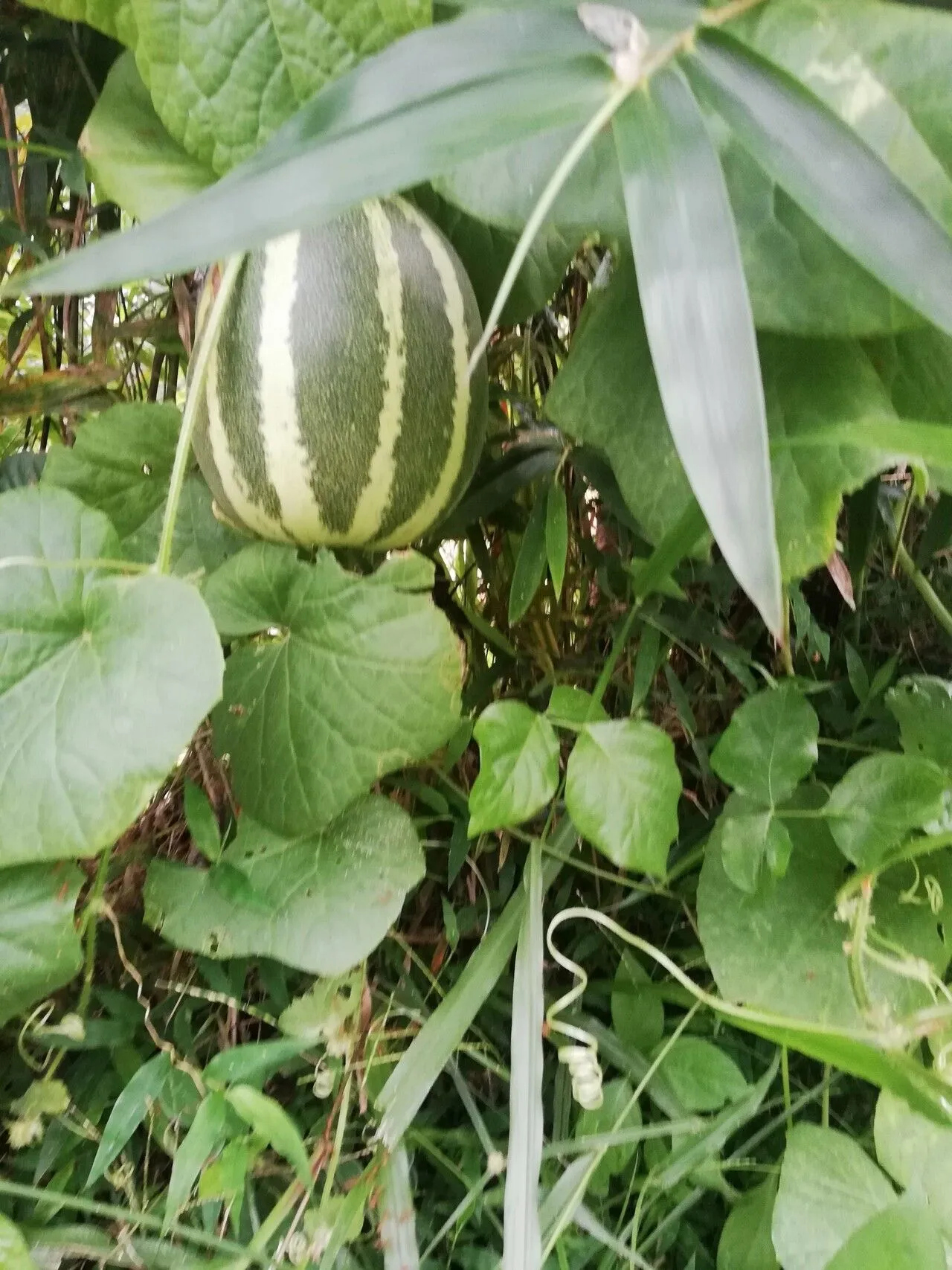
Author: Bouché
Bibliography: Verh. Vereins Beförd. Gartenbaues Königl. Preuss. Staaten 12: 205 (1837)
Year: 1837
Status: accepted
Rank: species
Genus: Cucurbita
Vegetable: False
Observations: Peru to Bolivia
The Figleaf Gourd, scientifically known as Cucurbita ficifolia, is a remarkable plant belonging to the Cucurbitaceae family. Described and classified by the botanist Bouché in the early 19th century, this gourd species was first noted in 1837 in the publication “Verh. Vereins Beförd. Gartenbaues Königl. Preuss. Staaten.”
Originating from the regions extending from Peru to Bolivia, the Figleaf Gourd thrives in these South American climates. This plant is distinguished by its notable similarities to other gourds, but with unique characteristics that set it apart. The Figleaf Gourd gets its common name from the shape of its leaves, which resemble those of the fig tree (Ficus carica).
The plant is a vigorous annual or perennial vine, depending on the growing conditions. It tends to grow robustly, producing elongated, climbing stems that can spread extensively. This makes it an excellent plant for covering trellises or arbors, creating plentiful foliage and visual interest in gardens.
The fruit of the Figleaf Gourd is also notable. It is typically oblong or cylindrical, and has a distinct mottled or striped skin in shades of green, turning to cream or yellowish hues as it matures. The interior flesh is white, and it is highly valued in various traditional cuisines across its native range. The seeds, encased within the fruit’s flesh, are larger compared to those of other gourd species and are edible.
Culinary-wise, the Figleaf Gourd is versatile. In its immature state, the fruit can be used similarly to zucchini or summer squash. Mature fruits are often harvested for their seeds or used in making beverages, desserts, and preserves. Additionally, the flesh of mature fruits is used in processing sweets and traditional dishes, taking advantage of its mild taste and firm texture.
Apart from its culinary uses, the Figleaf Gourd is also valued for its potential health benefits. It is rich in vitamins and minerals and is noted for its antioxidant properties. The plant’s resilience and adaptability make it a favored choice for cultivation, especially in regions that match its native habitat’s climate and conditions.
Overall, Cucurbita ficifolia is a plant of significant agricultural and horticultural interest. Its adaptability, rich cultural history, and diverse uses make it a fascinating subject for both study and cultivation.
Eng: asian pumpkin, figleaf gourd, malabar gourd, thai marrow, blackseed squash, cidra, fig leaf squash, fig-leaf gourd, shark fin melon, sidra, fig-leaved gourd
Deu: feigenblatt-kürbis, feigenblattkürbis
Spa: lacayote, chilacayota, chilacayote, chiverri, lacoyote, silacayote
Por: aboboreira-gila, abóbora-chila, chila, gila
Fra: courge à feuilles de figuier
En: Figleaf gourd, Asian pumpkin, Black-seed Squash, Black-Seeded Gourd, Black-Seeded Squash, Fig Leaf Squash, Fig-leaf gourd, Fig-leaved Gourd, Malabar gourd, Pie melon, Seven Year Melon, Thai Marrow, Blackseed squash, Cidra, Shark fin melon, Sidra
Ar: بذر القرع
Zh: 魚翅瓜
Cs: Tykev fíkolistá
Nl: Vijgenbladpompoen
Eo: Figfolia melono
Fr: Courge de Siam, Courge à feuilles de figuier
De: Feigenblatt-Kürbis, Feigenblattkürbis
Hu: Fügelevelű tök
Fa: کدوی تخمسیاه
Pl: Dynia figolistna
Pt: Chila-caiota, Aboboreira-gila, Abóbora-chila, Chila, Gila
Ru: Тыква фиголистная
Es: Lacayote, Chilacayota, Chilacayote, Chiverri, Lacoyote, Silacayote
Taken Aug 13, 2021 by robert_99 (cc-by-sa)
Taken Aug 13, 2021 by robert_99 (cc-by-sa)
Taken Jul 30, 2020 by B Erin (cc-by-sa)
Taken Sep 15, 2020 by J G (cc-by-sa)
Taken Aug 13, 2021 by robert_99 (cc-by-sa)
Taken Jul 27, 2021 by Maarten Vanhove (cc-by-sa)
Taken Jul 27, 2021 by Maarten Vanhove (cc-by-sa)
Taken Aug 22, 2022 by Anatas (cc-by-sa)
Taken Sep 5, 2020 by Sabaté Sant Jordi (cc-by-sa)
Taken Aug 5, 2022 by Huschi (cc-by-sa)
Taken Jul 27, 2021 by Maarten Vanhove (cc-by-sa)
Taken Jul 4, 2020 by Vinuga Gunarathna (cc-by-sa)
Taken Oct 19, 2020 by Borrás Patricia (cc-by-sa)
Taken Nov 28, 2022 by ansgar schönhoff (cc-by-sa)
Taken Oct 13, 2022 by Zenebe Wubshet (cc-by-sa)
Taken Sep 5, 2021 by Jannie Tuinenga (cc-by-sa)
Taken Oct 31, 2021 by Menaldo Élcio (cc-by-sa)
Taken Oct 5, 2022 by Kai Best (cc-by-sa)
Taken Sep 5, 2020 by Sabaté Sant Jordi (cc-by-sa)
© copyright of the Board of Trustees of the Royal Botanic Gardens, Kew.
© copyright of the Board of Trustees of the Royal Botanic Gardens, Kew.
© copyright of the Board of Trustees of the Royal Botanic Gardens, Kew.
Growth habit>: Forb/herb, Vine
Family: Myrtaceae Author: (F.Muell.) K.D.Hill & L.A.S.Johnson Bibliography: Telopea 6: 402 (1995) Year: 1995 Status:…
Family: Rubiaceae Author: Pierre ex A.Froehner Bibliography: Notizbl. Bot. Gart. Berlin-Dahlem 1: 237 (1897) Year:…
Family: Sapindaceae Author: Koidz. Bibliography: J. Coll. Sci. Imp. Univ. Tokyo 32(1): 38 (1911) Year:…
Family: Asteraceae Author: A.Gray Bibliography: Pacif. Railr. Rep.: 107 (1857) Year: 1857 Status: accepted Rank:…
Family: Fabaceae Author: Medik. Bibliography: Vorles. Churpfälz. Phys.-Ökon. Ges. 2: 398 (1787) Year: 1787 Status:…
Family: Aspleniaceae Author: (Cav.) Alston Bibliography: Bull. Misc. Inform. Kew 1932: 309 (1932) Year: 1932…